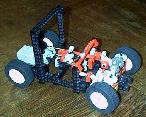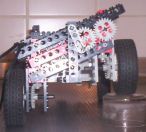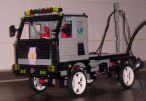



March 2004. Classical LEGO gearing boxes have been realized by numerous LEGO enthusiasts, Most of them were realized with 3 forward and 1 reverse transmission. I have implemented one a very long time ago in a 4-wheel drive (quad-quad). The first automated gearing LEGO transmission was demonstrated by Jeff Jahr His idea was to use the resisting force that slows down the car, or even blocks, the motor for switching gears.
In the car manufacturing industry there is also interest in continously variable transmissions (CVT's). The first LEGO CVT I have seen was created by Rob Stehlik A very nice website with lots of real life examples and explanantions was created by Vitor Barata It will take hours and hours of playing with LEGO to get all these ideas realized in LEGO. From this site I have selected two designs for a CVT. The first design is a very old patented invention by George Constantinescu . The second one has been invented and patented by Terry Lester I have converted this one to an infinitely variable transmission (IVT) using a new dsign for planetay gears as a "powersplitter".
October 2004. The third one is a continously variable belt transmission. The inspiration came from http://british.nerp.net/lego/
November 2004. I have updated the pages with the ratcheting CVT and the belt CVT with pictures from Pete Peterson.
January 2005. After all the CVT experiments , I got inspiration from Misha van Beek to look into other more classical solutions. Further, I tried to do a LEGO demonstratoin of angular velocity modulation by universal joints for the purpose of realizing a CVT.
October 2005. Since my brother has bought a hybrid car, I have been working on a simulation of a hybrid CVT-IVT power train.
November 2005. After having built the hybrid CVT and some older CVT designs, I want to get some theoretical understanding . Therefore I have started work on a page that shows the mathematical relations between angular speeds in differentials and planetary wheel assemblies. The results still need some validation. My next step is to find and show relations betweenthe in and output torques in these designs.
March 2008. As a result from comments of a webviewer, I have built a new version of the Constantinescu Torque Converter